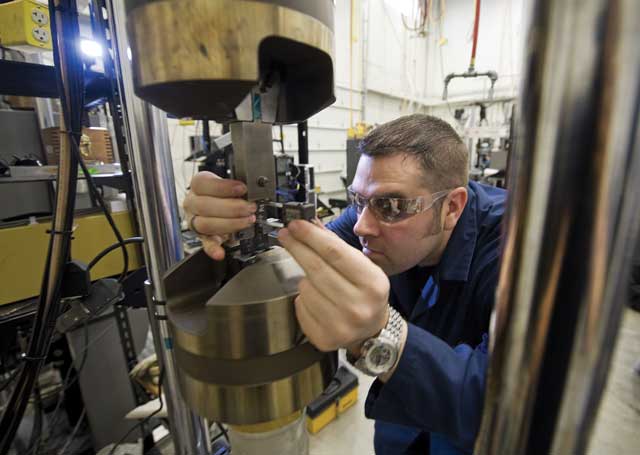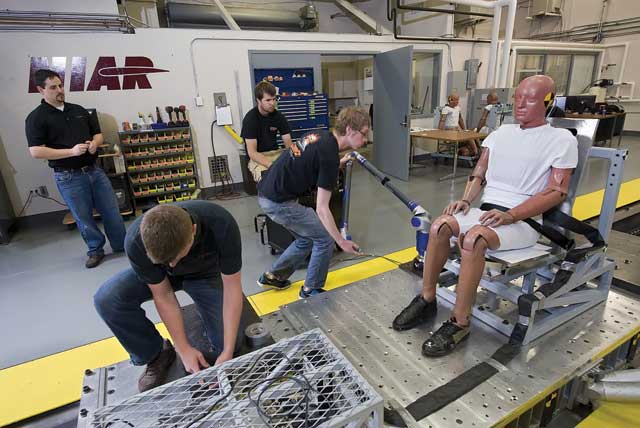In a moment of feverish brainstorming in 2002, Cessna executives desperate for trained aviation mechanics considered taking over an abandoned Wichita hotel and converting it into a dormitory. The residents would learn in a Cessna classroom in the morning and in the afternoon work on a then-booming assembly line.
The idea died as soon as someone bothered to work out a cost estimate, recalls Mike Edwards, who then managed Cessna's training department. "That didn't transpire," he says.
But such is the urgency for skilled labour. Even in an aviation manufacturing hub boasting a 30,000-strong labour pool, it seems there are always too many workers in the lean times, and too few in the good times.
On top of that timeless dynamic, the advances of modern aircraft manufacturing have imposed a different set of demands on the workforce. There was a time when a mechanically savvy worker with no formal education could find employment anywhere in the aviation industry - but those days are long passed.
Even an entry-level worker on a final assembly line in the era of digital-based aircraft manufacturing needs formal training and certificated skills. When the last great boom for general aviation erupted in 2002, no such formal education was available in Wichita, except through on-the-job training programmes by the manufacturers themselves.
 |
|---|
NCAT trains up to 1,300 workers a year in various aerospace manufacturing skills |
The five Wichita-based original equipment manufacturers - Boeing, Bombardier, Cessna, Hawker Beechcraft and Spirit AeroSystems - decided that needed to change.
"The five competitors came together," says Edwards, now the dean of manufacturing technology at the school that was formed in response.
United by a single cause, the leaders of the five airframers called on the state to establish a new technical school dedicated to training a new cadre of aviation workers. They argued that other existing and emerging clusters - Seattle, and even Chihuahua, Mexico - already boasted technical schools with strong aviation manufacturing training programmes. Wichita's workforce needed to keep pace, or be over-taken in a global competition for skilled labour.
Besides, 20,000 experienced, skilled aviation workers in the Wichita community are expected to retire in the next 20 years, and something needed to fill that gigantic gap.
The result was the National Center for Aviation Training (NCAT), a complex of three buildings that trains up to 1,300 workers each year in the manufacture of aerostructures, avionics and composites, among several other disciplines. It would be equipped to offer students hands-on training on the latest aviation manufacturing technology, including five-axis drilling machines and an autoclave for heat-curing composite structures.
"It was pure individual leadership on the part of these OEMs," says Tony Kinkel, NCAT president. "The next generation of workers have got to be better trained and better prepared. And each of [the OEMs] individually probably can't do a good enough job to retain world dominance. We need an entity [where] all they do is to become the best in the country in training."
The concept was based on the National Institute for Aviation Research, a branch of Wichita State University founded in the early 1990s. It brought what is now a world-class resource in aerospace sciences, with the benefits shared between Wichita-based airframers. The manufacturers wanted a similar, pooled resource that could deliver hundreds of skilled workers to the assembly line every year in good times, and allow employees a place to upgrade their skills in the bad times.
 |
|---|
The NIAR's curriculum is customised to a specific Wichita-based airframer or student |
The curriculum is uniquely customised to the specific employer and the specific student who enrolls. The school uses a different set of entrance tests for students based on the needs of a particular company. Students are offered instruction only in the areas where they fall below a standard on the entrance test.
"We are tremendously specialised in meeting your needs exactly where you are," Kinkel says. "We don't say you didn't pass our plate test, now you go take our 16-semester course. It's tailored to exactly where you're deficient."
If the NCAT lacked anything, however, it was good timing. The school was conceived at the height of the last great general aviation boom, but the bulk of its $53 million appropriation from the Kansas state legislature did not need to be spent until the market collapsed. The school finally opened on 27 October 2010, at arguably the very bottom of the post-2007 general aviation industry bust.
"The tremendous political leadership that it took to invest in these resources when they were going through the worst possible time is unbelievable," says Kinkel, who is himself a former state legislator in Minnesota. "It turned out to be the best time to invest because we could go nowhere but up."
Wichita does not need another general aviation boom to justify the existence of the NCAT. While the general aviation industry continues to struggle to recover to pre-2008 levels, demand for skilled labour is bursting in the commercial aviation sector. Alone among the five major original equipment manufacturers in Wichita, Spirit AeroSystems never had a lay-off during the global financial crisis. Now, it is hiring new workers by the hundreds each year to keep pace with demand, and it is hungry for skilled labour.
Not surprisingly, Jeff Turner, chief executive of Spirit AeroSystems, is a board member for NCAT and one of its biggest champions in the community. He has been haunted by a vision of an ageing skilled workforce retiring en masse by the end of this decade, with a lack of qualified labour to replace them.
Spirit AeroSystems no longer builds aircraft using drill presses on flat templates. That kind of work is outsourced to cheaper locations. The company builds modern aircraft with advanced tooling, using numerical control machines and five-axis drills programmed using 3D, digital blueprints.
"A technically trained and proficient workforce for the future is really important," Turner says. "If we ever lose the skilled capable workforce, that's what can destroy this cluster, because ultimately it is the workforce that does the design and the build of the products. "
Source: Flight International























